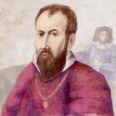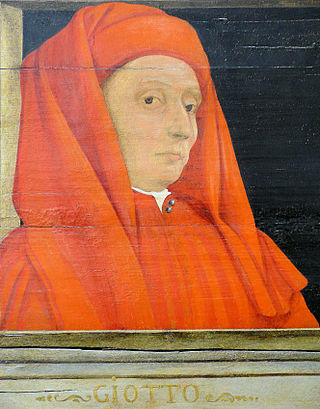
Padua is a city and comune in Veneto, northern Italy, and the capital of the eponymous province of Padua. The city lies on the banks of the river Bacchiglione, 40 kilometres west of Venice and 29 km southeast of Vicenza, and has a population of 214,000. It is also the economic and communications hub of the area. Padua is sometimes included, with Venice and Treviso, in the Padua-Treviso-Venice Metropolitan Area (PATREVE) which has a population of around 2,600,000.

Jacopo Bellini was one of the founders of the Renaissance style of painting in Venice and northern Italy. His sons Gentile and Giovanni Bellini, and his son-in-law Andrea Mantegna, were also famous painters.

Andrea Mantegna was an Italian painter, a student of Roman archeology, and son-in-law of Jacopo Bellini.

Antonio Vivarini was an Italian painter of the early Renaissance-late Gothic period, who worked mostly in the Republic of Venice. He is probably the earliest of a family of painters, which was descended from a family of glassworkers active in Murano. The painting dynasty included his younger brother Bartolomeo and Antonio's son Alvise Vivarini.

Melozzo da Forlì was an Italian Renaissance painter and architect. His fresco paintings are notable for the use of foreshortening. He was the most important member of the Forlì painting school.

Ansuino da Forlì was an Italian painter of the Quattrocento period. Born and active in Forlì and Padua in the mid-15th century, he was a member of a Forlì painting school and influenced the great Melozzo da Forlì.

Italian Renaissance painting is the painting of the period beginning in the late 13th century and flourishing from the early 15th to late 16th centuries, occurring in the Italian Peninsula, which was at that time divided into many political states, some independent but others controlled by external powers. The painters of Renaissance Italy, although often attached to particular courts and with loyalties to particular towns, nonetheless wandered the length and breadth of Italy, often occupying a diplomatic status and disseminating artistic and philosophical ideas.
The decade of the 1440s in art involved some significant events.

The Church of the Eremitani, or Church of the Hermits, is a former-Augustinian, 13th-century Gothic-style church in Padua, region of the Veneto, Italy. It is also now notable for being adjacent to the Cappella Scrovegni with Giotto frescoes and the municipal archeology and art gallery: the Musei Civici agli Eremitani, which is housed in the former Augustinian monastery located to the left of the entrance.

The Adoration of the Magi or Uffizi Triptych is a group of three tempera-on-panel paintings by Andrea Mantegna, dating to around 1460. Their three subjects are the Ascension of Christ, Adoration of the Magi the largest and central panel and the Circumcision of Christ. They were gathered as a trio in the 19th century, although some art historians doubt that they were created as a triptych set as they are arranged. They are in the Uffizi Gallery in Florence.

The San Zeno Altarpiece is a polyptych altarpiece by the Italian Renaissance painter Andrea Mantegna created around 1456–1459. It remains in situ in the Basilica di San Zeno, the main church of the Northern Italian city of Verona. Mantegna's style mixes Greco-Roman classical themes along with Christian subjects in this altarpiece. The central panel, along with the three paintings that comprise the predella, were taken in 1797 by the French. While the main, central scene was returned by the French to Verona in 1815, the three predella paintings in Verona today are copies, since the original ones remain in France at the Louvre (Crucifixion) and in the Musée des Beaux-Arts in Tours. The paintings are made with tempera on panel; not oil as mistakenly identified in one source.

The Camera degli Sposi, sometimes known as the Camera picta, is a room frescoed with illusionistic paintings by Andrea Mantegna in the Ducal Palace, Mantua, Italy. During the fifteenth century when the Camera degli Sposi was painted, Mantua was ruled by the Gonzaga, who maintained Mantua's political autonomy from its much stronger neighbors Milan and Venice by bidding their support out as a mercenary state. By commissioning Mantegna to paint the chamber, Ludovico III Gonzaga, the Marquis of Mantua, sought to give the Gonzaga rule more cultural credibility at a time when other Northern Italian courts such as the Ferrara were commissioning their own “painted chambers”.
Giovanni d'Alemagna was a Venetian renaissance painter of German ancestry, active in Italy, with his brother-in-law Antonio Vivarini on religious paintings in Venice and Padua, that are preserved in the named cities together with those of Vivarini.

Giotto di Bondone, known mononymously as Giotto and Latinised as Giottus, was an Italian painter and architect from Florence during the Late Middle Ages. He worked during the Gothic and Proto-Renaissance period. Giotto's contemporary, the banker and chronicler Giovanni Villani, wrote that Giotto was "the most sovereign master of painting in his time, who drew all his figures and their postures according to nature" and of his publicly recognized "talent and excellence". Giorgio Vasari described Giotto as making a decisive break from the prevalent Byzantine style and as initiating "the great art of painting as we know it today, introducing the technique of drawing accurately from life, which had been neglected for more than two hundred years".

The Adoration of the Shepherds is a painting by the northern Italian Renaissance artist Andrea Mantegna, dated to c. 1450-1451.

The Ovetari Chapel is a chapel in the right arm of the Church of the Eremitani in Padua. It is renowned for a Renaissance fresco cycle by Andrea Mantegna and others, painted from 1448 to 1457. The cycle was destroyed by an Allied bombing in 1944: today, only two scenes and a few fragments survive, which have been restored in 2006. They are, however, known from black-and-white photographs.

The Crucifixion is a panel in the central part of the predella of a large altarpiece painted by Andrea Mantegna between 1457 and 1459 for the high altar of San Zeno, Verona (Italy). It was commissioned by Gregorio Correr, the abbot of that monastery.

The Mantegna funerary chapel is one of the chapels of the Basilica of Sant'Andrea, Mantua. It houses the tomb of the painter Mantegna and his last two paintings – Baptism of Christ and Holy Family with St John the Baptist, St Elizabeth and St Zacharias (1504–1506). Its frescoes from 1507 were painted by his sons Ludovico and Francesco and by a young Correggio. The tomb bears a bronze figure of Mantegna by Gianmarco Cavalli.

Nicolò Pizzolo, also known as Nicolò di Pietro di Giovanni or with surname spelled Pizolo, was an Italian painter from Padua.
Isola Mantegna is a village within the comune (municipality) of Piazzola sul Brenta in Veneto, Italy. The town was initially named Isola di Carturo but changed its name to Isola Mantegna in 1963 to honor the notable Renaissance painter Andrea Mantegna, who was born there in 1431.


















